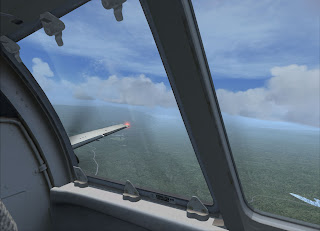It looked great in the pics on the VR website. I called customer support a few times and had all my questions answered before I bought the throttle. I am extremely apprehensive about spending $800 not having first examined what I was buying. It took a great leap of faith on my part to buy this site unseen.
The quadrant arrived and I ran to get a knife to open this thing up. Opening the box I smelled what turned out to be fresh paint. I pulled the throttle quadrant out of the box and the throttle knobs were still tacky with paint. It looked like they were painted with a paintbrush by a kid in a kindergarten art class and not allowed to properly dry. One of the reverser knobs was loose and fell off. The bolt used to hold it on was too short and the nut had one thread attaching it. I was upset to put it mildly. The quadrant looked great, and first impression was that it was engineered well despite the problems.
I noticed that the knobs on my throttle were different than in the pictures I had seen. The knobs pictured on the website and these were different in material and size. The website pic also shows metal throttle levers which were not present on my throttle.
The throttle quadrant is made almost entirely from polycarbonate plastic which is more flexible than I would have liked. Without the aluminum plate sandwiched in the throttle lever there is not as much rigidity as I would like to have. It was explained to me that the aluminum throttle lever was only for those who ordered the auto throttle option which I did not. It would have been nice to have made a note on the website that this would be omitted from models without auto throttles.
Whenever you move a lever it is polycarbonate rubbing on polycarbonate. It makes a squeaky cheap sound and doesn't provide for the smoothest movement. It would have been nice to have seen some type of lubrication used to make things smoother and quieter. Polycarbonate cracks very easily. This throttle is delicate and is not a toy. Care needs to be taken when handling it.
Assigning functions to each control on the throttle quadrant using the instructions and the utility included with Vista was very easy. It took about 10 minutes.
You will need to buy a USB cord to connect the throttle to your computer as it is not included. Vista recognized it immediately and loaded drivers. The USB port is located on the bottom of the quadrant so you will need to mount this on something you can drill a hole in to pass the USB cord through to reach the quadrants USB port. I imagine most people are going to build a home cockpit so this shouldn't be an issue.
Using a quadrant like this adds tremendously to the realism and sim experience. The quadrant resembles a 757/767/777 quadrant and has controls for stabilizer trim, spoilers, throttles, reversers, flaps, stab trim cutout switches, fuel cutoff switches, TO/GA switches and an optional parking brake switch with LED light which I opted for.
Something that wasn't explained to me was that the switches do not operate normally. Up is not "on" and down is not "off". The switches need to be moved through one cycle of up and then down in order to move the switch on the flight sim screen. So sometimes up is on and sometimes down is on. This is true for the parking brake and the start levers. The thrust reversers are either "open" in MCT reverse or "stowed" there is no way to modulate reverse thrust. It seems it's a software issue there is no working around as it was explained to me. This is moderately annoying and wished this would have been explained to me as well before I bought it. Maybe this was my ignorance.
I had to call VR a few times for the throttle knob issue and for technical questions when setting up the throttle. I had no problem reaching someone when I needed to and my e-mails were answered quickly.
My replacement knobs were sent out to me and arrived quickly. It was explained to me that they were not happy with the knobs they sent in the first place. I'm not really sure why they sent them. The replacements were better, but still not the ones in the VR website pictures. I am still pursuing an answer to the question as to why the knobs were changed. I would prefer to have the ones on their website.
I understand that a product like this isn't mass produced like something from Saitek or CH. Injection molding components isn't an option. Using more aluminum in the construction would have made this unaffordable for me. So I am willing to accept some issues and make compromises. Overall I am happy with the throttle so far. Time will tell if this quadrant ages gracefully or falls apart. If it breaks easily it won't be worth any price. It's going to get a lot of use.















